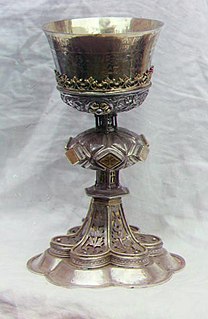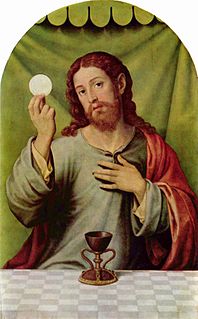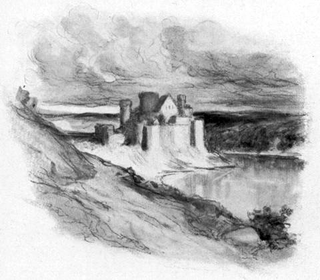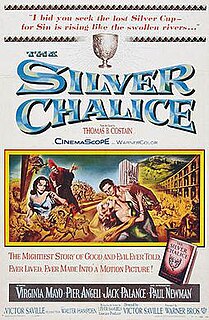
The Holy Grail is a treasure that serves as an important motif in Arthurian literature. Various traditions describe the Holy Grail as a cup, dish, or stone with miraculous powers: providing eternal youth, or sustenance in infinite abundance, often in the custody of the Fisher King. By analogy, any elusive object or goal of great significance may be perceived as a holy grail by those seeking it.

The Round Table is King Arthur's famed table in the Arthurian legend, around which he and his knights congregate. As its name suggests, it has no head, implying that everyone who sits there has equal status. The table was first described in 1155 by Wace, who relied on previous depictions of Arthur's fabulous retinue. The symbolism of the Round Table developed over time; by the close of the 12th century it had come to represent the chivalric order associated with Arthur's court, the Knights of the Round Table.

The Last Supper is the final meal that, in the Gospel accounts, Jesus shared with his apostles in Jerusalem before his crucifixion. The Last Supper is commemorated by Christians especially on Maundy Thursday. The Last Supper provides the scriptural basis for the Eucharist, also known as "Holy Communion" or "The Lord's Supper".

Joseph of Arimathea was, according to all four canonical gospels, the man who assumed responsibility for the burial of Jesus after his crucifixion. The historical location of Arimathea is uncertain, although it has been identified with several towns. A number of stories that developed during the Middle Ages connect him with Glastonbury, England and also with the Holy Grail legend.

A chalice or goblet is a footed cup intended to hold a drink. In religious practice, a chalice is often used for drinking during a ceremony or may carry a certain symbolic meaning.

In Arthurian legend, the Fisher King, also known as the Wounded King or Maimed King, is the last in a long bloodline charged with keeping the Holy Grail. Versions of the original story vary widely, but he is always wounded in the legs or groin and incapable of standing. All he is able to do is fish in a small boat on the river near his castle, Corbenic, and wait for some noble who might be able to heal him by asking a certain question. In later versions, knights travel from many lands to try to heal the Fisher King, but only the chosen can accomplish the feat. This is achieved by Percival alone in the earlier stories; he is joined by Galahad and Bors in the later ones.

Conquests of Camelot: The Search for the Grail is a graphic adventure game released in 1990 by Sierra On-Line. It was the first game in the Conquests series designed by Christy Marx and her husband Peter Ledger. The only other game in the series was 1991's Conquests of the Longbow: The Legend of Robin Hood. Marx did the majority of the design work while Ledger created the game and package art.

The Holy Chalice, also known as the Holy Grail, is in Christian tradition the vessel that Jesus used at the Last Supper to serve wine. The Synoptic Gospels refer to Jesus sharing a cup of wine with the Apostles, saying it was the covenant in his blood. The use of wine and chalice in the Eucharist in Christian churches is based on the Last Supper story. In the late 12th century, the author Robert de Boron associated the pre-existing story of the Holy Grail, a magical item from Arthurian literature, with the Holy Chalice. This association was continued in many subsequent Arthurian works, including the Lancelot-Grail (Vulgate) cycle, the Post-Vulgate Cycle, and Sir Thomas Malory's Le Morte d'Arthur. A cup kept in the Spanish Cathedral of Valencia has been identified since Medieval times as the purported Holy Chalice used at the Last Supper.
Robert de Boron was a French poet of the late 12th and early 13th centuries, notable as the reputed author of the poems Joseph d'Arimathie and Merlin. Although little is known of him apart from the poems he allegedly wrote, his works and subsequent prose redactions of them had a strong influence on later incarnations of the Arthurian legend and its prose cycles, particularly through their Christian back story for the Holy Grail.

Arma Christi, or the Instruments of the Passion, are the objects associated with the Passion of Jesus Christ in Christian symbolism and art. They are seen as arms in the sense of heraldry, and also as the weapons Christ used to achieve his conquest over Satan. There is a group, at a maximum of about 20 items, which are frequently used in Christian art, especially in the Late Middle Ages. Typically they surround either a cross or a figure of Christ of the Man of Sorrows type, either placed around the composition, or held by angels.
Richard Harris Leigh was a novelist and short story writer born in New Jersey, United States to a British father and an American mother, who spent most of his life in the UK. Leigh earned a BA from Tufts University, a master's degree from the University of Chicago, and a PhD from the State University of New York at Stony Brook.

A Glastonbury Romance was written by John Cowper Powys (1873–1963) in rural upstate New York and first published by Simon and Schuster in New York City in March 1932. An English edition published by John Lane followed in 1933. It has "nearly half-a-million words" and is "probably the longest undivided novel in English".
The Jesus bloodline refers to the proposition that a lineal sequence of descendants of the historical Jesus has persisted to the present time. The claims frequently depict Jesus as married, often to Mary Magdalene, and as having descendants living in Europe, especially France but also the UK. Differing and contradictory Jesus bloodline scenarios, as well as more limited claims that Jesus married and had children, have been proposed in numerous modern books. Some such claims have suggested that Jesus survived the crucifixion and went to another location such as France, India or Japan.
Josephus, also called Josephe or Josephes, is the son of Joseph of Arimathea and an early keeper of the Holy Grail in some tellings of the Arthurian legend. He makes appearances in the Quest del Saint Graal section of the Lancelot-Grail cycle, but his story is fully told in the Estoire del Saint Grail, a prequel section written somewhat later. In the Estoire he is invested as bishop by an apparition of Jesus with the implication that he was the first to receive his orders. Josephus is considered the primary holy man of the group, which is in contrast with the Lancelot-Grail's major source, Robert de Boron's Joseph d'Arimathie, in which his father is the undisputed leader. This is likely due to the authors' assertion that various great families are descended from Joseph; his virtuous son remains chaste and has no children.

Corbenic is the name of the Grail castle, the edifice housing the Holy Grail in Arthurian legend. It is a magical domain of the Grail keeper, often known as the Fisher King. The castle's descriptions vary greatly in different sources, and it first appears by that name in the Lancelot-Grail cycle where it is also the birthplace of Galahad.

The Silver Chalice is a 1954 American historical epic drama film directed and produced by Victor Saville, based on Thomas B. Costain's 1952 novel of the same name. It was Saville's last film and marked the acting debut of Paul Newman; despite being nominated for a Golden Globe Award for his performance, Newman later called it "the worst motion picture produced during the 1950s".

The Basilica of the Holy Blood is a Roman Catholic basilica in Bruges, Belgium. The church houses a relic of the Holy Blood allegedly collected by Joseph of Arimathea and brought from the Holy Land by Thierry of Alsace, Count of Flanders. Built between 1134 and 1157 as the chapel of the Count of Flanders, it was promoted to a minor basilica in 1923.
The Holyrood or Holy Rood is a Christian relic alleged to be part of the True Cross on which Jesus died. The word derives from the Old English rood, meaning a pole and the cross, via Middle English, or the Scots haly ruid. Several relics venerated as part of the True Cross are known by this name, in England, Ireland and Scotland.

Elaine (Helaine) or Elizabeth, also known as Amite, and identified as the "Grail Maiden" or the "Grail Bearer", is a character from Arthurian legend. In the Arthurian chivalric romance tradition, she is the daughter of the Fisher King, King Pelles of Corbenic, and the mother of Galahad from her rape of Lancelot. She should not be confused with Elaine of Astolat, a different woman who too fell in love with Lancelot.

The silver-gilt Antioch chalice was created around AD 500-550. Currently it is on view at The Metropolitan Museum of Art Fifth Avenue in Gallery 300. When it was discovered, the interior cup of the chalice was initially considered to be the Holy Chalice, the cup used by Christ at the Last Supper. Recently, it has been concluded that it may have been a standing oil lamp and not a chalice.















